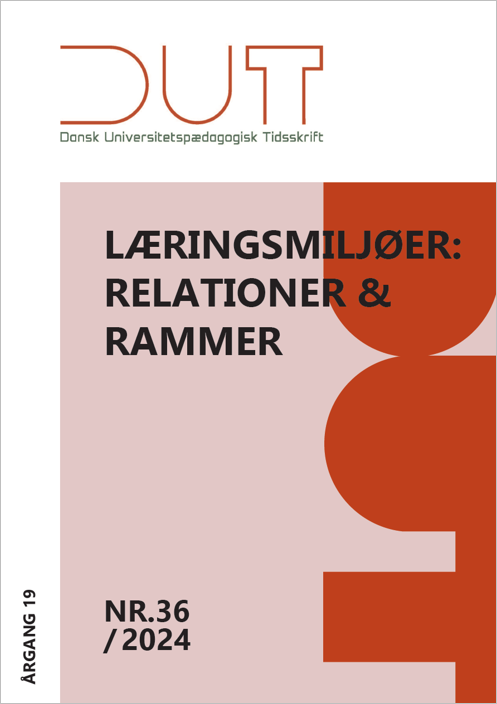Creating a motivating environment in a programming course using a two-track exercise split
DOI:
https://doi.org/10.7146/dut.v19i36.140251Abstract
Abstract
In our society, programming and IT literacy are important skills. However, in introductory courses in higher education, there is a struggle to design the coursework in a way that engages and motivates both beginners and people who already know some code.
This paper presents a case study that explores the design of optional exercise sessions as a shorter 'fast track' for experienced or well-prepared students, and a longer 'normal track' for those who need help with the technical parts of the coursework. The case is analysed using self-determination theory to investigate student motivation in such a design.
Students perform well and are generally happy to be able to choose between tracks to find their own fit. Whether a 2-day induction workshop or a track split leads to the best learning environment is a question for future research.
References
Alvarado, C., Umbelino, G., & Minnes, M. (2018, February). The persistent effect of pre-college computing experience on college CS course grades. In Proceedings of the 49th ACM Technical Symposium on Computer Science Education (pp. 876-881). https://doi.org/10.1145/3159450.3159508
Bandura, A. (2006). Toward a psychology of human agency. Perspectives on psychological science, 1(2), 164-180. https://doi.org/10.1111/j.1745-6916.2006.00011.x
Borsotti, V. (2018, May). Sigsoft distinguished paper - Barriers to gender diversity in software development education: Actionable insights from a Danish case study. In 2018 IEEE/ACM 40th International Conference on Software Engineering: Software Engineering Education and Training (ICSE-SEET) (pp. 146-152). IEEE. https://doi.org/10.1145/3183377.3183390
Bundsgaard, J., Bindslev, S., Caeli, E. N., Pettersson, M., & Rusmann, A. (2019). Danske elevers teknologiforståelse: resultater fra ICILS-undersøgelsen 2018. Aarhus Universitetsforlag.
Cohoon, J. P., & Tychonievich, L. A. (2011, March). Analysis of a CS1 approach for attracting diverse and inexperienced students to computing majors. In Proceedings of the 42nd ACM technical symposium on Computer science education (pp. 165-170). https://doi.org/10.1145/1953163.1953217
Daniel, B. (2015). Big Data and analytics in higher education: Opportunities and challenges. British journal of educational technology, 46(5), 904-920. https://doi.org/10.1111/bjet.12230
DEA & Microsoft (2019) Hvordan får vi STEM på lystavlen hos børn og unge? - Og hvilken rolle spiller køn for interesseskabelsen? https://www.datocms-assets.com/22590/1605692412-deastem-rapport-endelig.pdf
Eickelmann, B. (2019). Measuring secondary school students' competence in computational thinking in ICILS 2018-challenges, concepts, and potential implications for school systems around the world. In Computational thinking education (pp. 53-64). Springer, Singapore. https://doi.org/10.1007/978-981-13-6528-7_4
Fisher, A., & Margolis, J. (2003, January). Unlocking the clubhouse: Women in computing. In Proceedings of the 34th SIGCSE technical symposium on Computer science education (p. 23). https://doi.org/10.1145/611892.611896
Grabarczyk, P., Nicolajsen, S. M., & Brabrand, C. (2022, November). On the Effect of Onboarding Computing Students without Programming-Confidence or-Experience. In Koli Calling'22: 22nd Koli Calling International Conference on Computing Education Research (pp. 1-8). https://doi.org/10.1145/3564721.3564724
Jenkins, T., & Davy, J. (2002). Diversity and motivation in introductory programming. Innovation in Teaching and Learning in Information and Computer Sciences, 1(1), 1-9. https://doi.org/10.11120/ital.2002.01010003
Marcher, M. H., Christensen, I. M., Grabarczyk, P., Graversen, T., & Brabrand, C. (2021, August). Computing Educational Activities Involving People Rather Than Things Appeal More to Women (CS1 Appeal Perspective). In Proceedings of the 17th ACM Conference on International Computing Education Research (pp. 145-156). https://doi.org/10.1145/3446871.3469761
Miles, M. B., Huberman, A. M., & Saldaña, J. (2014). Qualitative data analysis: A methods sourcebook. 3rd.
Mishkin, A. (2019, February). Applying self-determination theory towards motivating young women in computer science. In Proceedings of the 50th ACM Technical Symposium on Computer Science Education (pp. 1025-1031). https://doi.org/10.1145/3287324.3287389
Niemiec, C. P., & Ryan, R. M. (2009). Autonomy, competence, and relatedness in the classroom: Applying self-determination theory to educational practice. Theory and research in Education, 7(2), 133-144. https://doi.org/10.1177/1477878509104318
Robins, A., Rountree, J., & Rountree, N. (2003). Learning and teaching programming: A review and discussion. Computer science education, 13(2), 137-172. https://doi.org/10.1076/csed.13.2.137.14200
Tomkin, J. H., & Charlevoix, D. (2014, March). Do professors matter? Using an a/b test to evaluate the impact of instructor involvement on MOOC student outcomes. In Proceedings of the first ACM conference on Learning@ scale conference (pp. 71-78). https://doi.org/10.1145/2556325.2566245
Downloads
Published
How to Cite
Issue
Section
License
DUT udkommer elektronisk via Statsbibliotekets Open Journal System (Tidsskrift.dk) og DUNs hjemmeside (DUN-net.dk) forår og efterår. Det er gratis og frit tilgængeligt at læse og downloade artikler fra tidsskriftet.
Det er ikke muligt at abonnere på Dansk Universitetspædagogisk Tidsskrift, DUT, men hvis du er medlem af DUN, får du tilsendt en nyhedsmail med link til udgivelsen, når den nyeste udgave er online. Linket vil også være tilgængeligt her på siden, så snart tidsskriftet er publiceret.
© Copyright
Artikler publiseret i Dansk Universitetspædagogisk Tidsskrift, DUT, må bruges (downloades) og genbruges (distribueres, kopieres, citeres) til ikke-kommercielle formål med reference til forfattere og Dansk Universitetspædagogisk Tidsskrift.
Artikler indsendt til Dansk Universitetspædagogisk Tidsskrift må ikke publiseres i andre tidskrifter.
Betingelser
Artikler i Dansk Universitetspædagogisk Tidsskrift, DUT, er omfattet af ophavsretsloven, og der må citeres fra dem.
Følgende betingelser skal dog være opfyldt:
- Citatet skal være i overensstemmelse med „god skik“
- Der må kun citeres „i det omfang, som betinges af formålet“
- Ophavsmanden til teksten skal krediteres, og kilden skal angives ift. ovenstående bibliografiske oplysninger.





